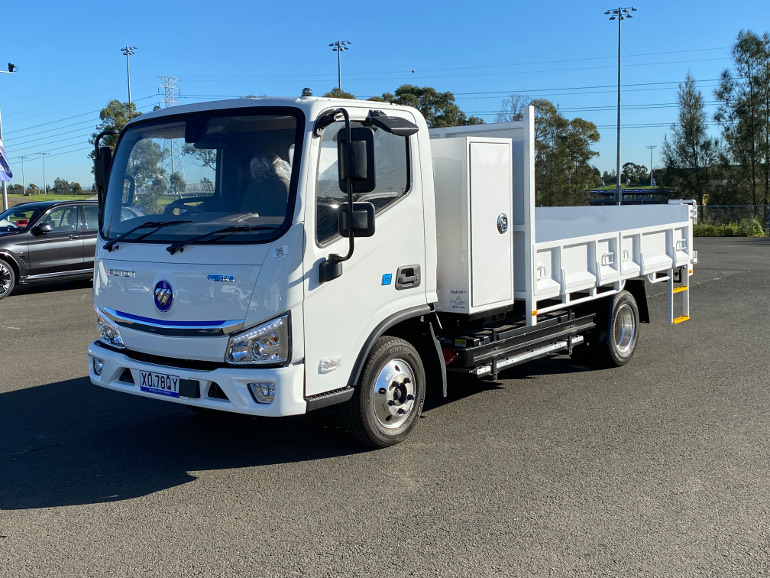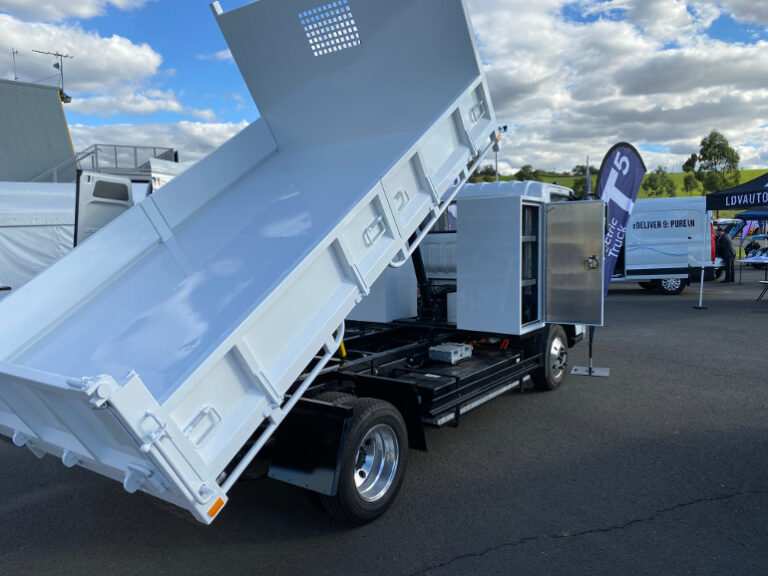After fronting the media at the Brisbane Truck Show in his new role as General Manager – Light Vehicles at Foton Mobility Distribution (FMD), I caught up with Bill Gillespie to find out more about FMD and their plans to leverage their initial success with the T5 light duty electric truck.
During the interview, Gillespie discusses the great furphy that light-duty electric trucks need a range of 300km, and how a tipper body has opened the eyes of potential buyers.
Tell us about Foton Mobility, where do they sit globally and their plans for new energy vehicles?
Foton globally is an enormous business; they are the number one commercial vehicle manufacturer in China and have been for the last 18 years. I recently had the pleasure of visiting their global headquarters, and it is a seriously impressive operation.
Foton represents around half of the global zero-emission truck and other commercial vehicle sales last year. Annually, the company produces over 450,000 vehicles, and by 2030, half of all production will be New Energy Vehicles, a mixture of hydrogen and battery electric products. Currently, New Energy Vehicles account for around 5% of production.
Obviously, the Chinese domestic market is very strong for the brand, but it also has a foothold throughout the rest of Asia, into South America, while it is also gaining traction in Europe.
By the end of 2030, the company plans to produce 250,000 new energy trucks and buses annually.
What about Australia, what products will they be selling here?
Foton Mobility Australia is the sole distributor in Australia for the Foton zero-emission vehicles that include hydrogen and EV trucks, buses, and soon hydrogen prime mover trucks.
Today, we distribute the Foton T5 light duty truck in both a 4,500kg car licence configuration, while the same truck can be specified with a 6,000kg light rigid licence variant for those applications that require a higher payload.
In addition to this, we plan to add to that range by the end of 2024 and into early 2025 with a medium-duty truck yet to be defined in terms of its final GVM.
Throughout Australia, we have a strong network of dealerships in place for sales and service, as well as a gathering of complementary businesses that help ease the transition for companies into the new technology.
Is Foton planning to sell electric vans in Australia?
We are going to bring in Foton vans, the company has some products currently in development. We are aiming to have the first units arrive before the end of the year for initial testing and ADR requirements, and then we will bring those to market in 2024.
What size will the vans be?
There’s a low roof last mile van and a 10 cubic metre high roof van as well.
With the light-duty truck you’re selling today, what has been the response from the market?
You may have seen the news recently from Woolworths with their purchase of 25 of the Foton T5 4,500kg rated trucks, which comes complete with their proven refrigerated body.
The bodies are from TRS and locally built in Sydney. It’s their current provider of bodies for their diesel trucks as well, with these new units being split between their Mascot and Caringbah distribution centres.
We did an extensive induction program with the Woolworths drivers and their staff to make the most of the EV experience.
The trucks go out in the morning, do their deliveries, and then receive a top-up charge in the middle of the day before heading back out again. They are running around 150-160 kilometres, with deliveries in the demanding Sydney traffic, and completing a large number of drops each day.
We’ve installed a lot of safeguards to assist Woolworths fleet operations, including having NTI as our roadside support partner. We haven’t had any vehicles stop on the road, but NTI has been on hand to answer any questions that pop up, for instance, ‘When I get back, what do I have to do again to charge the truck?’ Having that reassurance on call is great for our customers.
The trucks have been performing to the metrics demanded by Woolworths, and more importantly by their customers, who appreciate all the positives that come with a quiet, non-polluting delivery vehicle.
The one area that you would suspect “might” be the biggest challenge would be the refrigerated body and the draw on the battery. To date there has been no issue at all with the traction battery as the draw from the refrigerator motor is only in the range of 1.2 kilowatts per hour.
So does the FMD solution involve charging? Or have they installed special charging infrastructure?
Woolworths have installed their own AC chargers at their depot in Mascot and will adopt DC fast charging in Caringbah to enable one-hour fast charging times.
Is there software to manage the vehicles, monitor the battery levels and charging loads?
Woolworths have access to their own data through Geotab to track the state of charge and location and other important metrics related to truck performance and deliveries. The software also monitors that the trucks are being charged correctly when they return, ensuring that they’re ready to go again first thing the next day.
Besides Woolworths, what other markets have shown interest in an electric truck?
The interest is huge with many companies contacting us to talk about all types of applications. We now have a tipper model, which we’ve shown to 30-plus councils in New South Wales.
Recently Foton displayed the truck at the Australian local government show in Canberra with positive feedback from all attendees.
And just recently, EnergyAustralia has been using one of the T5 tippers at one of their new energy sites.
Interest in the tipper has been great, because for a lot of fleets, seeing is believing. This isn’t a last-mile application, this is a real truck operating in a real environment in their world.
Another strong selling point of the T5 is that it can tow. It’s got a 3,500kg braked towing capacity, making it ideal for councils to tow around mowers and small backhoes.
So far, the feedback on that feature from drivers is one of great surprise, as they simply had no idea an electric truck could tow. The trucks don’t do a lot of kilometres either, they go out mowing around their local area, so it’s not like they need a huge range.
There is a great misconception in Australia about the range urban, or even regional-based, trucks and vans require. We acknowledge that there are applications that need to drive 300 kilometres fully laden in a day. However, for many fleets in this space, a prospective range of under 200 kilometres per charge is significantly more than enough.







